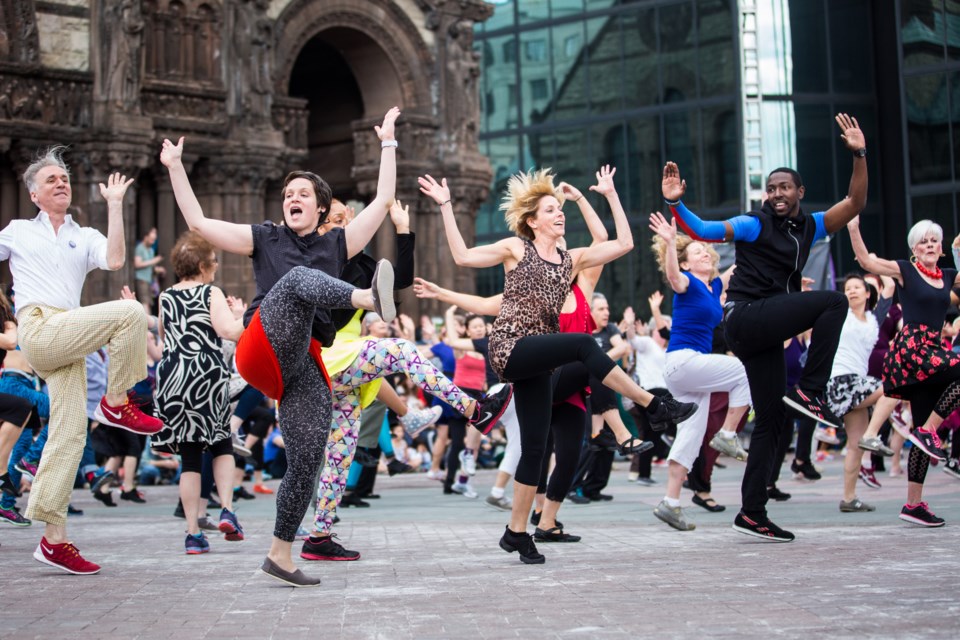Dozens of eyes surreptitiously follow a former ski instructor-turned-talented dancer while another performer counts out the steps. Twenty of us grab our butts and swivel, gallop, plié and throw our hands in the air.
We cluster in twos and threes when the beats stop to work out the bits that trip us up. I need to figure out how it’s possible to kick my left foot first in the sequence called Champagne. I’m one of more than 70 dancers performing in Le Grand Continental as part of the PuSh International Performing Arts Festival, which runs Jan. 20 to Feb. 8.
Created by Montreal choreographer Sylvain Émard, Le Grand Continental is a free public performance featuring dancers of all abilities from all walks of life.
Participants, like myself, heard about the opportunity and an open audition at the Roundhouse community centre through social media and word of mouth.
Now we’ve got 30 minutes of choreography to perfect for four outdoor performances (rain or shine) at the Queen Elizabeth Plaza, Jan. 24 and 25.
In September I attended a birthday party where five of us picked a song (Madonna’s “Like a Virgin”), choreographed corresponding moves (we slunk like tigers) and performed for an audience of six. It was ridiculous and fun. Learning choreography from professionals and performing in the venerable PuSh festival with other amateur dancers seemed like the next logical step. I liked the idea of participating in a performance instead of just writing about one, and I was keen to be more engaged and connect with new people in my community.
Le Grand Continental was first performed in Montreal in 2009. It had become a joke among dancers of Émard’s work that he always included a line dancing section. “That’s the first dance format I did as a kid,” he said. “It was very popular in the ’60s in Montreal.”
So Émard created a piece that combined elements of line dancing with contemporary dance for dancers of different experience levels.
“I like to deceive them to be sure that their love or interest for dance is going to increase with this experience,” he said.
The last Saturday before Christmas found 20 of us rehearsing instead of shopping, baking or revelling. It wasn’t even an official rehearsal. Keeners organized three extra practices over the winter break, including one on New Year’s Day, to keep the momentum going.
Anyone who knows me knows I love dancing. I even say so on my Twitter profile. But the time commitment, at least two two-hour rehearsals a week for three months, not including optional practice sessions, was even more intense than I anticipated. I needed those extra hours of repetition. I joked I didn’t have muscle memory; I had muscle amnesia.
At one point this thing I’d decided to take on as a self-confidence-boosting challenge became a self-esteem downer. I was reminded of how I much I sucked in school when it came to sports. Sure, I attended recreational ballet classes once a week for 10 years as a kid, but I lacked talent then, too. How was I possibly going to remember choreography for eight sections? Others were mastering and remembering steps and I wasn’t. But then I noted I wasn’t the only one at the extra Saturday sessions. Soon, we were picking up new sequences faster.
Dancers swiftly started grabbing rides and drinks together. Fledgling friendships started.
Now I’ve got dance buddies. We’re a team with a common purpose.
When you see us perform you’ll see people of different ages, shapes, ethnicities and persuasions. We’re a team made of mostly women but also eight men. Our troupe includes journalists, university professors, people who work in the arts and retirees. Some of us have had previous dance training, some of us have had none, but we’re all dancing enthusiasts. There’s the Latvian lovers that can barely keep their hands off one another, my friend Ling who unfailingly sports a dazzling getup and the Latin ladies who showed us how we could add spice to the salsa step.
Le Grand Continental has been performed in Ottawa, New York City, Philadelphia, Boston, Portland and Mexico City as well as in Montreal, and in each city the group of dancers has continued learning together.
“Even after two weeks we were already talking the same language,” Émard said.
He loves that amateurs discover they can learn 30 minutes of choreography in two months.
We’ve learned how to move to dreamy, funky and staccato techno sections of music, most of it composed and arranged by Montreal-based Martin Tétrault.
Émard hopes those who attend the 1 p.m. and 4 p.m. performances will see their friend, family member or coworker proudly and joyfully busting moves and think maybe they could do that too.
“I just want the audience to feel jealous,” Émard said.
We’ve got six mandatory rehearsals before show time, and there’s a dress rehearsal on the day of our first performance. What do I eat? Should I carb load the night before? What if there’s a torrential downpour? What am I going to wear? I like to dance like no one’s watching. How am I going to handle hundreds of eyes? These are the questions I must consider, for as one of the troupe likes to joke with a mock preen, now I am a dancer.
For more info about PuSh, see pushfestival.ca.



